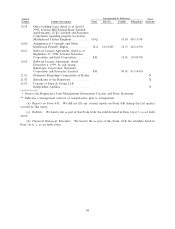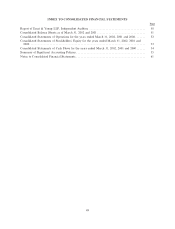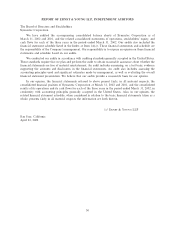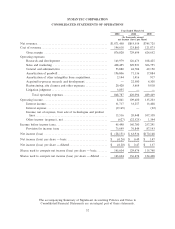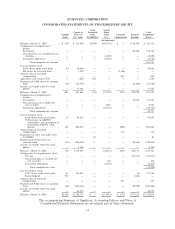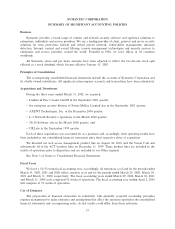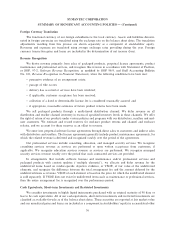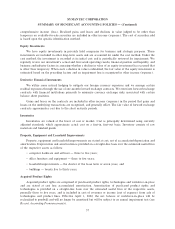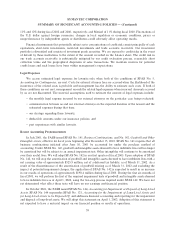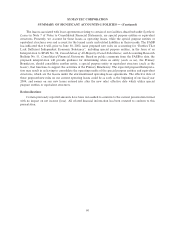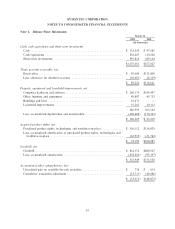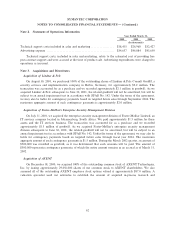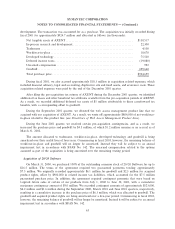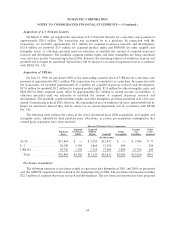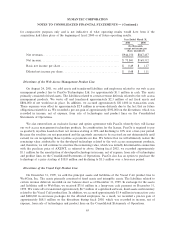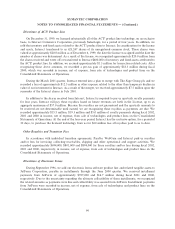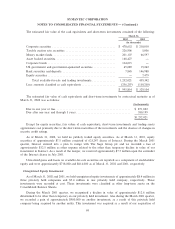Symantec 2002 Annual Report Download - page 80
Download and view the complete annual report
Please find page 80 of the 2002 Symantec annual report below. You can navigate through the pages in the report by either clicking on the pages listed below, or by using the keyword search tool below to find specific information within the annual report.SYMANTEC CORPORATION
SUMMARY OF SIGNIFICANT ACCOUNTING POLICIES Ì (Continued)
Goodwill
Goodwill is recorded through acquisitions and is stated at cost less accumulated amortization. For
acquisitions completed prior to July 1, 2001, amortization in each case was provided on a straight-line basis
over the estimated useful life of the respective goodwill, generally four to Ñve years, and was included in
operating expenses. EÅective April 1, 2002, the net balance of goodwill related to acquisitions completed prior
to July 1, 2001 will no longer be amortized but will be subject to an annual impairment test (see Recent
Accounting Pronouncements). For acquisitions completed subsequent to June 30, 2001, goodwill was not
amortized and will be subject to an annual impairment test.
Long-Lived Assets
Long-lived assets, including property, equipment, leasehold improvements, acquired product rights and
goodwill, are evaluated for impairment whenever events or changes in circumstances indicate that the carrying
amount of an asset may not be recoverable. An impairment loss would be recognized when the sum of the
undiscounted future net cash Öows expected to result from the use of the asset and its eventual disposition is
less than its carrying amount. Such impairment loss would be measured as the diÅerence between the carrying
amount of the asset and its fair value based on the present value of estimated future cash Öows. No
impairments have been indicated to date. EÅective April 1, 2002, impairment of goodwill and other long-lived
assets will be assessed according to new accounting guidelines (see Recent Accounting Pronouncements).
Income Taxes
Income taxes are computed in accordance with Statement of Financial Accounting Standards, or SFAS,
No. 109, Accounting for Income Taxes.
Stock-Based Compensation
We account for stock-based awards to employees using the intrinsic value method in accordance with
Accounting Principles Board Opinion, or APB, No. 25, Accounting for Stock Issued to Employees, and to
nonemployees using the fair value method in accordance with SFAS No. 123, Accounting for Stock-Based
Compensation. In addition, we apply applicable provisions of Financial Accounting Standards Board, or
FASB, Interpretation, or FIN, No. 44, Accounting for Certain Transactions Involving Stock Compensation,
an interpretation of APB No. 25.
Net Income (Loss) Per Share
Basic net income (loss) per share is computed using the weighted average number of common shares
outstanding during the periods. Diluted net income (loss) per share is computed using the weighted average
number of common shares outstanding and potentially dilutive common shares during the periods. Diluted net
income (loss) per share also includes the assumed conversion of all of the outstanding convertible
subordinated debentures and assumed exercising of options, if dilutive in the period. Potentially dilutive
common shares are excluded in net loss periods, as their eÅect would be antidilutive.
Concentrations of Credit Risk
Our product revenues are concentrated in the software industry, which is highly competitive and rapidly
changing. SigniÑcant technological changes in the industry or customer requirements, or the emergence of
competitive products with new capabilities or technologies, could adversely aÅect operating results. In
addition, a signiÑcant portion of our revenues and net income (loss) is derived from international sales and
independent agents and distributors. Distributors that accounted for more than 10% of net revenues included:
Ingram Micro Inc. of 23%, 26% and 39% during Ñscal 2002, 2001 and 2000, respectively; Tech Data Group of
58


